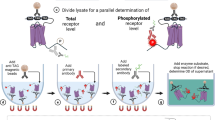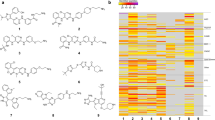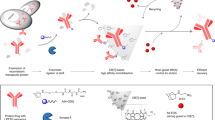Abstract
We have developed a method using novel latex beads for rapid identification of drug receptors using affinity purification. Composed of a glycidylmethacrylate (GMA) and styrene copolymer core with a GMA polymer surface, the beads minimize nonspecific protein binding and maximize purification efficiency. We demonstrated their performance by efficiently purifying FK506-binding protein using FK506-conjugated beads, and found that the amount of material needed was significantly reduced compared with previous methods. Using the latex beads, we identified a redox-related factor, Ref-1, as a target protein of an anti-NF-κB drug, E3330, demonstrating the existence of a new class of receptors of anti-NF-κB drugs. Our results suggest that the latex beads could provide a tool for the identification and analysis of drug receptors and should therefore be useful in drug development.
This is a preview of subscription content, access via your institution
Access options
Subscribe to this journal
Receive 12 print issues and online access
$209.00 per year
only $17.42 per issue
Buy this article
- Purchase on Springer Link
- Instant access to full article PDF
Prices may be subject to local taxes which are calculated during checkout






Similar content being viewed by others
References
Cuatrecasas, P., Wilchek, M. & Anfinsen, C.B. Selective enzyme purification by affinity chromatography. Proc. Natl. Acad. Sci. USA 61, 636–643 (1968).
Cuatrecasas, P. Affinity chromatography. Annu. Rev. Biochem. 40, 259–278 (1971).
Hogan, J.C., Jr. Directed combinatorial chemistry. Nature 384, 17–19 (1996).
Wada, T., Watanabe, H., Kawaguchi, H. & Handa, H. DNA affinity chromatography. Methods Enzymol. 254, 595–604 (1995).
Inomata, Y., Kawaguchi, H., Hiramoto, M., Wada, T. & Handa, H. Direct purification of multiple ATF/E4TF3 polypeptides from HeLa cell crude nuclear extracts using DNA affinity latex particles. Anal. Biochem. 206, 109–114 (1992).
Inomata, Y., Wada, T., Handa, H., Fujimoto, K. & Kawaguchi, H. Preparation of DNA-carrying affinity latex and purification of transcription factors with the latex. J. Biomater. Sci. Polym. Ed. 5, 293–302 (1994).
Harding, M.W., Galat, A., Uehling, D.E. & Schreiber, S.L. A receptor for the immunosuppressant FK506 is a cis-trans peptidyl- prolyl isomerase. Nature 341, 758–760 (1989).
Siekierka, J.J., Hung, S.H., Poe, M., Lin, C.S. & Sigal, N.H. A cytosolic binding protein for the immunosuppressant FK506 has peptidyl-prolyl isomerase activity but is distinct from cyclophilin. Nature 341, 755–757 (1989).
Hiramoto, M., et al. Nuclear targeted suppression of NF-κB activity by the novel quinone derivative E3330. J. Immunol. 160, 810–819 (1998).
Nakamura, H., Nakamura, K. & Yodoi, J. Redox regulation of cellular activation. Annu. Rev. Immunol. 15, 351–369 (1997).
Zwacka, R.M. et al. Redox gene therapy for ischemia/reperfusion injury of the liver reduces AP1 and NF-κB activation. Nat. Med. 4, 698–704 (1998).
Spencer, D.M., Wandless, T.J., Schreiber, S.L. & Crabtree, G.R. Controlling signal transduction with synthetic ligands. Science 262, 1019–1024 (1993).
Dignam, J.D., Lebovitz, R.M. & Roeder, R.G. Accurate transcription initiation by RNA polymerase II in a soluble extract from isolated mammalian nuclei. Nucleic Acids Res. 11, 1475–1489 (1983).
Mizushima, S. & Nagata, S. pEF-BOS, a powerful mammalian expression vector. Nucleic Acids Res. 18, 5322 (1990).
Matsuura, Y., Possee, R.D., Overton, H.A. & Bishop, D.H. Baculovirus expression vectors: the requirements for high level expression of proteins, including glycoproteins. J. Gen. Virol. 68, 1233–1250 (1987).
Hoque, M. et al. Nuclear transport of the major capsid protein is essential for adeno-associated virus capsid formation. J. Virol. 73, 7912–7915 (1999).
Watanabe, H., Wada, T. & Handa, H. Transcription factor E4TF1 contains two subunits with different functions. EMBO J. 9, 841–847 (1990).
Sawada, J. et al. Synergistic transcriptional activation by hGABP and select members of the activation transcription factor/cAMP response element-binding protein family. J. Biol. Chem. 274, 35475–35482 (1999).
Xanthoudakis, S., Miao, G.G. & Curran, T. The redox and DNA-repair activities of Ref-1 are encoded by nonoverlapping domains. Proc. Natl. Acad. Sci. USA 91, 23–27 (1994).
Acknowledgements
The authors are grateful to Eisai Co., Ltd. for providing E3330 and NH2-E3330. This work was supported in part by a research grant from Core Research for Evolutional Science and Technology (CREST) of Japan Science and Technology Cooperation (J.S.T.), Grant-in-Aid for Scientific Research on Priority Areas from the Ministry of Education, Science, Sports and Culture, and a grant of R and D Projects in Cooperation with Academic Institutions from New Energy and Industrial Technology Development Organization (NEDO). We thank Dr. David Buchanan for critical reading of the manuscript.
Author information
Authors and Affiliations
Corresponding author
Rights and permissions
About this article
Cite this article
Shimizu, N., Sugimoto, K., Tang, J. et al. High-performance affinity beads for identifying drug receptors. Nat Biotechnol 18, 877–881 (2000). https://doi.org/10.1038/78496
Received:
Accepted:
Issue Date:
DOI: https://doi.org/10.1038/78496
This article is cited by
-
APEX1 Nuclease and Redox Functions are Both Essential for Adult Mouse Hematopoietic Stem and Progenitor Cells
Stem Cell Reviews and Reports (2023)
-
Stabilization of CDK6 by ribosomal protein uS7, a target protein of the natural product fucoxanthinol
Communications Biology (2022)
-
Proteomics-based target identification of natural products affecting cancer metabolism
The Journal of Antibiotics (2021)
-
Small-molecule inhibition of APE1 induces apoptosis, pyroptosis, and necroptosis in non-small cell lung cancer
Cell Death & Disease (2021)
-
Proteome interrogation using gold nanoprobes to identify targets of arctigenin in fish parasites
Journal of Nanobiotechnology (2020)



